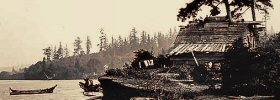
Language & Culture
Language
The Muckleshoot language is a dialect of Puget Salish, or whulshootseed. It belongs to the eastern Puget Sound group along with Nisqually, Puyallup, Suquamish, Duwamish, Squaxin, Stillaquamish, Snoqualmie, Skykomish, Snohomish, and Skajit. In addition, many Lummi, Nooksack, and Twana also knew the language. All of these areas now use English instead of their native languages, but some of the elders are beginning to teach the native language to the younger people.
The native language is quite different from the English, containing several sounds without English equivalent letters. Also, one native word can mean an entire sentence or concept in English. The alphabet consists of 41 sounds.
Because of the many different languages and because trade was carried on among several different tribes, the Chinook trade jargon grew. It contained the most easily understood or most used words from all different languages. As the influx of French and English speaking people grew, so also the jargon grew. This language, or jargon, was never meant to replace a language, but merely for use in facilitating trade. Perhaps if the ethnic balance had remained the same, with some modifications, Chinook could have become the universal language of the northwest.
The native Indian language was historically an oral language, having no written form. Between 1962 and 1974, Thom Hess from the Department of Linguistics, University of Victoria, Canada, worked with Earnie Barr, Eva Jerry, Bertha McJoe, Bernice Tanewasha, and Ellen Williams, all from Muckleshoot, and succeeded in converting the oral language to a written form. Because of the efforts of this group, the Muckleshoot language will not become a forgotten language.